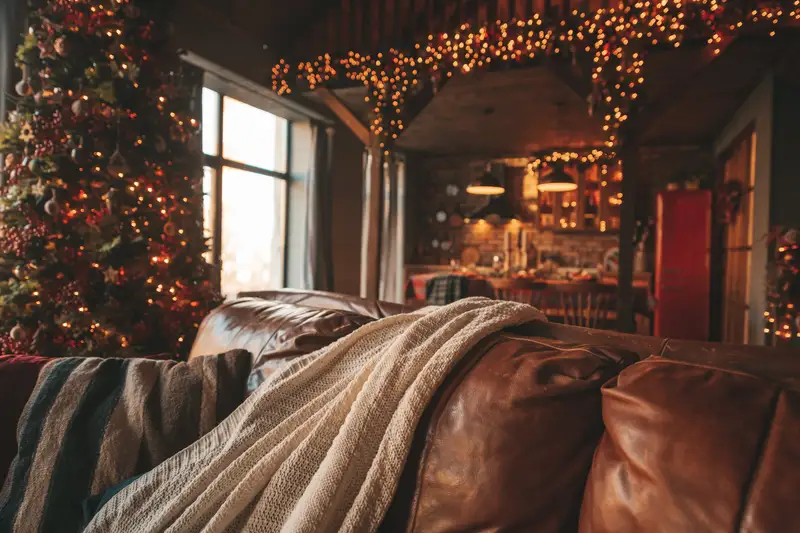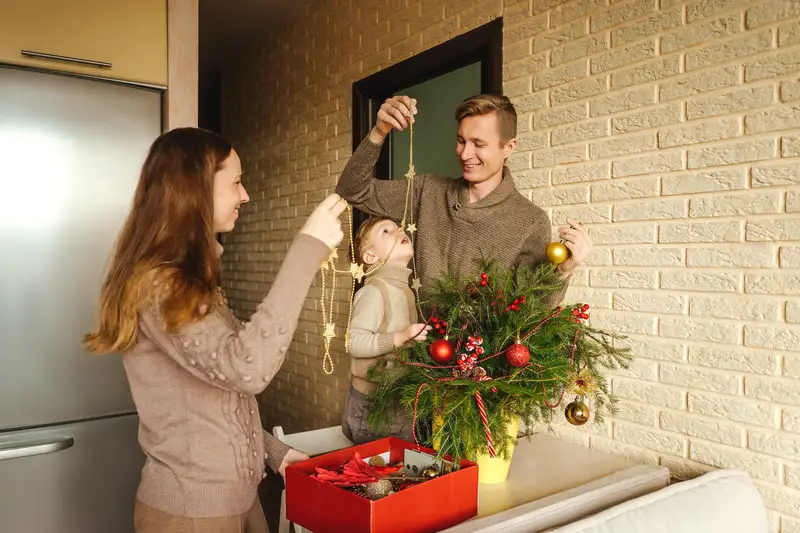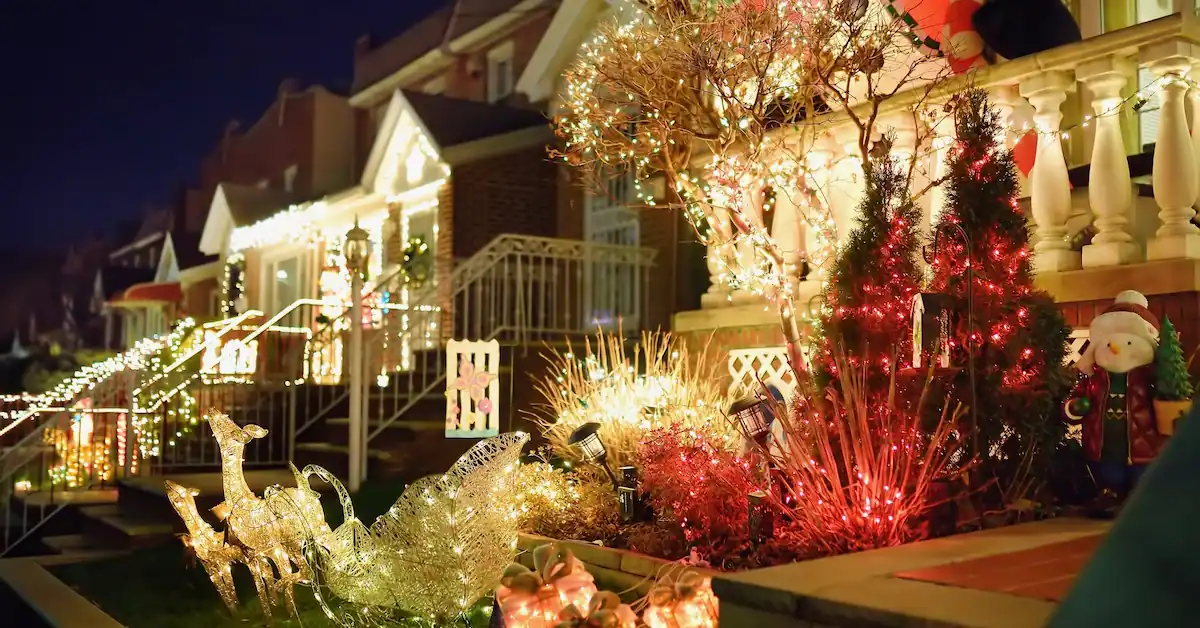When the holiday season rolls around, neighborhoods come alive with glowing displays that bring joy to streets and homes alike. Light is essential for mental well-being, with far-reaching effects on how we think, feel, and function. Our brains naturally react to different wavelengths of light, triggering physiological responses that influence emotions and sleep cycles.
Here’s how holiday lights improve mood, reduce stress, and foster meaningful connections during the winter months.
How Light Affects the Brain and Balances Moods

Holiday lights, often composed of vibrant reds, greens, and golds, tap into your biological response. Red tones ignite feelings of warmth and excitement, while green creates a sense of balance and renewal.
These displays also support healthy circadian rhythms—our internal clocks that regulate sleep and mood—by compensating for the limited daylight in winter. Research shows that the absence of natural light can disrupt melatonin production, contributing to sluggishness or sadness. Bright, colorful lights serve as a welcome intervention, mimicking sunlight’s benefits and helping maintain emotional balance.
The flickering patterns found in many holiday light setups provide a sensory experience similar to watching waves or staring at a crackling fire. Psychologists refer to these effects as “soft fascination,” moments of gentle mental engagement that foster relaxation without demanding intense focus. These soothing experiences encourage mindfulness, helping us slow down in the midst of holiday busyness and offering a break from everyday stress.
Easing Seasonal Affective Disorder (SAD) with Holiday Lights
Seasonal Affective Disorder (SAD) affects millions of people during the darker months, manifesting as low energy, poor sleep, and persistent sadness. While clinical treatments for SAD include light therapy, holiday lights offer complementary benefits that improve emotional well-being.
Bright light exposure increases serotonin, a neurotransmitter responsible for mood regulation, and boosts melatonin production, which promotes healthy sleep patterns. Integrating cheerful lights into home décor can subtly lift spirits, helping to counter the emotional drain many feel during the winter. Creating a vibrant environment with lights—indoors or outdoors—provides a boost, even if it doesn’t fully replace sunlight.

Holiday lights can also act as mood triggers, evoking positive associations with festive traditions and meaningful family moments. These visual cues stimulate the brain’s reward system, reinforcing feelings of joy and reducing stress. Though lights aren’t a cure for SAD, they create opportunities for small moments of happiness that can make a meaningful difference over time.
For those experiencing more severe symptoms, seeking support from healthcare providers remains essential, but holiday lights provide an accessible way to brighten the everyday.
Decorating with Lights is a Creative Outlet for Reducing Stress
Engaging in creative activities is a powerful tool for enhancing mental well-being, and decorating with holiday lights offers a unique avenue for self-expression. Positive psychology studies show that creativity triggers the brain’s reward pathways, reducing cortisol levels and boosting feelings of accomplishment. Whether designing an elaborate display for your front yard or simply stringing lights inside your home, the act of creating offers emotional benefits.
Holiday decorating also nurtures mindfulness. Observing the glow, patterns, and colors in a light display encourages us to be present, quieting anxious thoughts and fostering a sense of calm. Like meditation, these moments of focus help reduce mental clutter and provide a break from holiday pressures.

The beauty of light displays lies in their flexibility—there’s no “right” way to decorate. Experimenting with themes, layouts, and color combinations offers a playful experience, allowing each individual or family to express themselves. This creative engagement taps into intrinsic motivation, boosting mood and fostering resilience.
Simple Ways to Enjoy the Benefits of Holiday Lights
Holiday lights aren’t just for decoration—they also bring people together. Social connection is essential for mental health, and festive lights create opportunities to bond with family, friends, and neighbors. Studies show that participating in shared traditions strengthens emotional well-being by promoting a sense of belonging.
Walking through a neighborhood adorned with lights or attending local light festivals encourages social interaction and helps combat loneliness. Even something as simple as exchanging smiles with neighbors or sharing photos of favorite displays online fosters connection. Psychologists emphasize that these small interactions release oxytocin, a hormone that promotes trust and strengthens social bonds.
Decorating as a group—whether with family or friends—provides an opportunity for collaboration and quality time. Creating displays together fosters teamwork, enhances communication, and strengthens relationships. For those who can’t meet in person, sharing the experience virtually through video calls or photo tours offers meaningful ways to stay connected. These shared activities help build emotional bridges, making the holiday season feel more inclusive and joyful.

Incorporating lights into your daily routine doesn’t have to be complicated. Here are a few simple ways to make the most of holiday displays this season:
- Explore your neighborhood. Evening walks offer a chance to move your body, enjoy the fresh air, and appreciate festive lights. This combination of exercise and sensory stimulation can reduce stress and boost your mood.
- Create a personal display. Adding lights to your home, whether inside or out, brings a sense of accomplishment and creates a welcoming atmosphere. Even small touches like a string of fairy lights can transform a room.
- Visit light shows or festivals. Many communities host light displays that offer music, food, and activities, making them an ideal way to enjoy quality time with loved ones.
- Use light displays as a mindfulness practice. Take a moment to notice the colors, shapes, and glow of the lights around you. Allowing yourself to pause and engage with these details can help you feel grounded and calm.
- Share the experience with others. Whether decorating together or sending photos of your setup, sharing these moments fosters meaningful connections. If distance makes it hard to meet up, virtual light tours can still create a sense of closeness.
Frequently Asked Questions about Holiday Lights and Mental Health
1. Can holiday lights have measurable effects on mental health?
Yes. Light exposure affects serotonin levels, improving mood, and regulates melatonin, which supports better sleep. Holiday lights can mimic the positive effects of daylight, offering psychological relief during darker months.
2. How do holiday lights support people with Seasonal Affective Disorder (SAD)?
Bright lights are known to influence the brain’s serotonin system. While holiday lights aren’t a substitute for clinical light therapy, they create an uplifting environment that can ease some SAD symptoms by promoting serotonin production and aligning sleep cycles.
3. What colors of lights have the greatest impact on emotional well-being?
Red tones evoke energy and warmth, green promotes harmony, and gold fosters comfort. These colors can enhance emotional regulation by engaging neural pathways associated with mood and relaxation. Using diverse colors can offer a multi-sensory experience that encourages well-being.
4. How does decorating with lights reduce stress?
The act of decorating fosters mindfulness, which has been shown to lower cortisol levels and reduce anxiety. Engaging in creative tasks promotes flow, a mental state linked to happiness, giving people a sense of control and accomplishment.
5. Can holiday lights improve social bonds and community well-being?
Yes. Studies show that shared traditions, like decorating, strengthen social ties and foster belonging. Engaging in community events or decorating with family and friends releases oxytocin, enhancing trust and emotional connection, both crucial for well-being during the holidays.
Brighten Your Season with Mary’s Holiday Lights
At Mary’s Holiday Lights, we believe holiday displays do more than brighten homes—they uplift spirits, connect communities, and inspire creativity. As you enjoy the lights this season, take a moment to appreciate how they impact your well-being. Whether you’re setting up your own display or admiring your neighbors’ work, these little moments of light bring warmth and joy when we need them most.
If you’re ready to add extra sparkle to your home or neighborhood, we’re here to help. Together, let’s create displays that brighten both the season and the soul.

